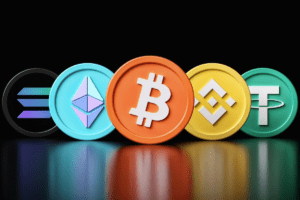Introduction to Solana
To understand Solana, it is essential to grasp the fundamentals of blockchain technology and how it has revolutionized various industries.
Understanding Blockchain Technology
Blockchain technology is a decentralized and distributed ledger system that enables secure and transparent transactions without the need for intermediaries. It provides a tamper-proof record of transactions that is maintained across multiple nodes in a network. This technology has gained significant attention for its potential to transform industries such as finance, supply chain, and healthcare, among others.
What Is Solana?
Solana is an open-source blockchain platform designed to address the scalability and performance limitations of traditional blockchain networks. It aims to provide a high-throughput, low-latency, and secure infrastructure for decentralized applications (dApps) and cryptocurrencies.
Built upon a unique combination of breakthrough technologies, Solana leverages a combination of Proof of History (PoH) and Proof of Stake (PoS) consensus algorithms to achieve fast transaction speeds and high scalability.
Solana’s architecture allows it to handle a vast number of transactions per second, making it suitable for applications that require high throughput, such as decentralized finance (DeFi), non-fungible tokens (NFTs), and gaming platforms.
By utilizing a combination of innovative techniques, Solana has positioned itself as a promising contender in the blockchain ecosystem. The Solana ecosystem is composed of various core components and features, which we will explore in the next section.
To delve deeper into Solana’s features and technical aspects, you can refer to the Solana whitepaper. Additionally, for a comprehensive overview of Solana’s tokenomics and token distribution, check out our article on Solana tokenomics.
Now, let’s dive into the core components and key features of the Solana ecosystem.
The Solana Ecosystem
To understand Solana, it’s important to explore its ecosystem, which comprises various core components and features that set it apart in the blockchain space.
The Core Components of Solana
Solana’s ecosystem is built upon several core components that work together seamlessly to provide a robust and scalable blockchain platform. These components include:
-
Solana Mainnet: The Solana Mainnet is the live network where transactions are processed and validated. It serves as the foundation for the entire Solana ecosystem, enabling secure and efficient blockchain operations.
-
Solana Token: The Solana Token is the native cryptocurrency of the Solana network. It plays a vital role in facilitating transactions, incentivizing network participants, and securing the network through staking. The Solana Tokenomics provide further insights into its utility and distribution.
-
Solana Validators: Validators are key participants in the Solana ecosystem responsible for validating transactions and maintaining the integrity of the network. They ensure consensus is reached through the innovative Proof of History (PoH) and Proof of Stake (PoS) consensus algorithms. Learn more about Solana Validators and their significance in the network.
-
Solana Roadmap: Solana’s roadmap outlines the future direction and development plans of the ecosystem. It highlights upcoming features, improvements, and innovations that will enhance the performance, scalability, and functionality of the Solana blockchain.
-
Solana Partnerships: Solana has formed strategic partnerships and collaborations with various organizations and projects across the blockchain and technology sectors. These partnerships aim to drive adoption, foster innovation, and expand the use cases of Solana within the wider ecosystem. Discover more about Solana’s partnerships and their impact.
Key Features of the Solana Ecosystem
Solana’s ecosystem offers several key features that contribute to its appeal and distinguish it from other blockchain platforms:
-
Scalability and High Throughput: Solana is designed to handle high transaction volumes and achieve fast transaction processing times. Its unique architecture, including features like Tower BFT consensus, enables it to scale horizontally, making it suitable for demanding decentralized applications and financial services.
-
Low Transaction Fees: Solana aims to provide cost-effective transactions by minimizing fees, making it more accessible to users and ensuring that transaction costs remain affordable even during peak network usage.
-
Energy Efficiency: Solana has made significant strides in optimizing energy consumption, minimizing its environmental impact compared to traditional blockchain platforms. This energy efficiency is achieved through its efficient consensus algorithms and innovative approach to transaction processing.
The Solana ecosystem is continually evolving, driven by ongoing development efforts, community participation, and the pursuit of cutting-edge solutions. As Solana progresses, it is expected to revolutionize the blockchain industry, offering new possibilities and opportunities for developers, businesses, and users alike. Stay updated with the latest developments and advancements in Solana’s ecosystem by exploring its roadmap and engaging with the community.
Solana’s Consensus Algorithm
In order to understand the inner workings of the Solana ecosystem, it’s essential to explore the consensus algorithm that powers it. Solana utilizes a combination of two consensus algorithms: Proof of History (PoH) and Proof of Stake (PoS).
Proof of History (PoH)
Proof of History (PoH) is a unique and innovative concept introduced by Solana. It acts as a cryptographic clock that provides a historical record of events in the network. PoH allows Solana to order and timestamp transactions without the need for all nodes to agree on the exact order. This greatly improves the scalability and throughput of the network by reducing the communication overhead.
The PoH algorithm works by creating a verifiable sequence of timestamps using a cryptographic function called a Verifiable Delay Function (VDF). This function ensures that the timestamps are generated at regular intervals, providing a reliable and auditable historical record. By leveraging this historical record, Solana achieves fast and efficient transaction processing.
Proof of Stake (PoS)
Proof of Stake (PoS) is another vital component of the Solana consensus algorithm. In a PoS system, validators are chosen to create new blocks and verify transactions based on the number of tokens they hold and are willing to “stake” as collateral. The more tokens a validator stakes, the higher their chances of being selected to create a new block.
Solana’s implementation of PoS allows for efficient block creation and validation, ensuring the integrity and security of the network. Validators play a crucial role in maintaining the decentralization and consensus of the Solana ecosystem. To learn more about Solana’s validators, you can visit our article on solana validators.
By combining Proof of History (PoH) and Proof of Stake (PoS), Solana achieves a high level of scalability, security, and decentralization. This unique consensus algorithm sets Solana apart from other blockchain platforms and enables it to handle a significantly higher transaction throughput compared to traditional blockchain networks.
Understanding the consensus algorithm is just one aspect of comprehending the Solana ecosystem. In the following sections, we will explore the benefits and advantages Solana offers, as well as its real-world applications in areas such as decentralized finance (DeFi), non-fungible tokens (NFTs), and gaming.
Benefits and Advantages of Solana
As an innovative blockchain ecosystem, Solana offers several notable benefits and advantages that set it apart from other platforms. These advantages include scalability and high throughput, low transaction fees, and energy efficiency.
Scalability and High Throughput
One of the key advantages of Solana is its exceptional scalability and high throughput capabilities. The Solana network is designed to handle a large number of transactions per second, making it suitable for applications that require fast and efficient processing.
Solana achieves this scalability through its unique architecture, which combines several innovative mechanisms. These mechanisms include a combination of Proof of History (PoH) and Proof of Stake (PoS) consensus algorithms, as well as a decentralized network of validators. By utilizing these techniques, Solana can achieve high transaction throughput, allowing for the rapid and reliable execution of smart contracts and decentralized applications (dApps).
To put this in context, Solana’s network is capable of processing thousands of transactions per second, making it well-suited for applications that require real-time interactions and high-speed data processing. For more information on Solana’s scalability, you can refer to our article on solana scalability.
Low Transaction Fees
In addition to its scalability, Solana also offers low transaction fees, making it cost-effective for users. The efficient design of the Solana network allows for the processing of a large number of transactions at a low cost, ensuring that users can transact and interact with the blockchain without incurring exorbitant fees.
The low transaction fees on the Solana network are particularly beneficial for users engaging in frequent transactions or utilizing decentralized applications. This affordability makes Solana an attractive option for developers and businesses looking to build on a blockchain platform without the burden of high transaction costs.
Energy Efficiency
Energy efficiency is another notable advantage of the Solana ecosystem. Unlike some other blockchain networks that rely on energy-intensive consensus mechanisms, such as Proof of Work (PoW), Solana utilizes the energy-efficient Proof of Stake (PoS) consensus algorithm.
By transitioning to PoS, Solana significantly reduces its energy consumption and carbon footprint compared to traditional PoW-based blockchains. This energy-efficient approach aligns with the growing global focus on sustainability and reduces the environmental impact associated with blockchain technology.
By leveraging its energy-efficient consensus mechanism, Solana provides a more sustainable platform for developers and users to build and interact with decentralized applications. This commitment to energy efficiency sets Solana apart in the blockchain ecosystem.
The benefits and advantages offered by Solana, including its scalability, low transaction fees, and energy efficiency, make it an attractive choice for developers, businesses, and users seeking a fast, cost-effective, and sustainable blockchain platform. As Solana continues to evolve and gain traction, its potential for widespread adoption and impact on various industries becomes increasingly apparent.
Use Cases and Applications of Solana
As Solana continues to gain traction in the blockchain space, its versatile ecosystem offers various use cases and applications. Let’s explore three prominent areas where Solana is making a significant impact: decentralized finance (DeFi), non-fungible tokens (NFTs), and gaming and virtual worlds.
Decentralized Finance (DeFi)
Solana’s high throughput and low transaction fees make it an ideal platform for decentralized finance (DeFi) applications. DeFi refers to a set of financial applications built on blockchain technology that aim to recreate and enhance traditional financial systems without intermediaries.
On the Solana network, DeFi protocols can facilitate activities such as lending, borrowing, trading, and yield farming. The fast transaction processing speed, achieved through Solana’s scalable architecture, enables a seamless user experience and efficient liquidity management. With Solana’s focus on scalability and high throughput, DeFi projects built on the Solana blockchain can handle a large number of transactions per second, providing users with a smooth and cost-effective DeFi experience.
Non-Fungible Tokens (NFTs)
Another thriving area within the Solana ecosystem is the use of non-fungible tokens (NFTs). NFTs are unique digital assets that represent ownership or proof of authenticity of a particular item, whether it’s art, music, virtual real estate, or collectibles.
Solana’s fast transaction confirmation time and low fees make it an attractive option for creators and collectors in the NFT space. Artists can mint and sell their digital artwork on Solana-based NFT platforms, while collectors can securely purchase and trade NFTs with ease. The high throughput of the Solana network ensures that NFT marketplaces can handle a large volume of transactions, providing a seamless experience for both creators and buyers.
Gaming and Virtual Worlds
Solana’s scalability and low latency make it well-suited for gaming and virtual world applications. The Solana network enables developers to create decentralized gaming platforms and virtual worlds with real-time interactions and near-instant transaction confirmations.
By leveraging Solana’s high throughput, gaming developers can build immersive experiences that can handle a large number of players simultaneously. Solana’s low transaction fees ensure that in-game transactions, such as buying virtual assets or trading items, can be conducted cost-effectively.
Furthermore, Solana’s fast block confirmation time allows for real-time interactions within virtual worlds, delivering a seamless and immersive gaming experience. The Solana ecosystem provides an ideal foundation for the development of decentralized gaming applications, fostering innovation and creativity within the gaming industry.
Solana’s versatility extends beyond these three use cases, with potential applications in areas such as supply chain management, data storage, and more. As the Solana ecosystem continues to evolve, the opportunities for innovation and adoption across various industries are vast.
To learn more about Solana’s technical aspects, check out the Solana whitepaper. For the latest updates on Solana’s roadmap and partnerships, visit our article on Solana partnerships.
The Future of Solana
As Solana continues to gain recognition and momentum within the blockchain community, its future holds both potential challenges and exciting growth opportunities.
Potential Challenges
While Solana has proven itself as a scalable and high-performance blockchain platform, it is not without potential challenges. One of the main challenges that Solana may face is increasing competition from other blockchain platforms. As the blockchain space evolves, new platforms emerge, each with its own unique features and capabilities. Solana will need to continue innovating and differentiating itself to stay ahead in this competitive landscape.
Another challenge that Solana may encounter is the need to maintain a strong and decentralized network of validators. Validators play a crucial role in securing the Solana network and validating transactions. As the network grows, it will be essential to ensure a diverse and robust set of validators to maintain the integrity and security of the ecosystem. For more information on validators, you can refer to our article on solana validators.
Outlook and Growth Potential
Despite potential challenges, Solana’s outlook remains positive, and its growth potential is significant. The Solana ecosystem has already gained attention and support from various industry players, including developers, investors, and institutions. Its impressive scalability, high throughput, and low transaction fees make it an attractive option for decentralized applications (dApps), decentralized finance (DeFi), non-fungible tokens (NFTs), and gaming applications.
Solana’s roadmap outlines several exciting developments and initiatives that are expected to shape its future. This includes ongoing research and development to further enhance the platform’s scalability, security, and functionality. Solana’s commitment to continuous improvement and innovation positions it well for future growth and adoption. To learn more about Solana’s roadmap, you can visit our article on solana roadmap.
Furthermore, Solana’s strategic partnerships and collaborations with various projects and organizations contribute to its growth potential. By forging alliances with industry leaders and supporting innovative projects, Solana aims to expand its ecosystem and attract a diverse range of applications and users. To explore Solana’s partnerships, refer to our article on solana partnerships.
As Solana continues to mature and evolve, it has the potential to become a prominent player in the blockchain space. Its advanced features, energy efficiency, and developer-friendly environment make it an appealing choice for individuals and businesses looking to leverage blockchain technology. Whether Solana will realize its full potential and become a mainstream blockchain platform remains to be seen, but its progress thus far demonstrates its capabilities and sets a solid foundation for future growth.



